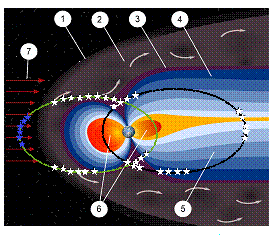Science & Technology
1-D Simulation Code to Study Earth’s Magnetosphere
- 04 May 2020
- 5 min read
Why in News
Scientists at the Indian Institute of Geomagnetism (IIG) have developed a generalized one-dimensional fluid simulation code capable of studying a wide spectrum of coherent electric field structures in near-earth plasma environments or earth’s magnetosphere.
- The developed simulation code is expected to help in planning of future space missions.
Key Points
- Formation of Earth’s Magnetosphere:
- Sun is the major source of plasma deposition in space around the Earth. Thus, the Sun forces some of its plasma towards the earth in the form of the solar wind.
- Plasma is the most common state of matter in the universe as a whole.It consists of a gas of ions and free electrons.
- The speed of solar wind varies between 300 to 1500 km/s, which carries with it a solar magnetic field, called the Interplanetary Magnetic Field (IMF).
- The interaction of the IMF with the earth’s magnetic field creates the magnetosphere of the earth.
- The magnetosphere shields our home planet from solar and cosmic particle radiation, as well as erosion of the atmosphere by the solar wind - the constant flow of charged particles streaming off the sun.
- Sun is the major source of plasma deposition in space around the Earth. Thus, the Sun forces some of its plasma towards the earth in the form of the solar wind.
- Regions of the Earth’s Magnetosphere:

- The schematic diagram of Earth’s magnetosphere shown consists of different regions namely,
- Bow shock : It occurs when the magnetosphere of an Earth interacts with the nearby flowing ambient plasma such as the solar wind.
- Magnetosheath: It is the region of space between the magnetopause and the bow shock of a planet's magnetosphere.
- Magnetopause : It is the boundary between the planet's magnetic field and the solar wind.
- Northern tail lobe : The magnetosphere of the earth contains two lobes, referred to as the northern and southern tail lobes. Magnetic field lines in the northern tail lobe point towards the earth.
- Southern tail lobe: The magnetic field lines in the southern tail lobes point away from the earth. Usually, the tail lobes are almost empty, with few charged particles opposing the flow of the solar wind.
- Plasmasphere : The plasmasphere, or inner magnetosphere, is a region of the Earth's magnetosphere consisting of low energy (cool) plasma.
- Solar winds: It is a stream of charged particles released from the upper atmosphere of the Sun, called the corona.
- The schematic diagram of Earth’s magnetosphere shown consists of different regions namely,
- Significance of Study of Plasma Processes:
- The plasma processes have the ability to hamper the working of a number of satellites that have been placed in orbit in the magnetospheric region.
- However, the morphology of these plasma processes changes over space and time. These changes can be ideally deciphered only through computer simulations.
- The study will help advance the knowledge of plasma waves, instabilities, and coherent effects associated with wave-particle interactions that are useful in planning future space missions.
- It can also lead to precisely controlled fusion laboratory experiments for ever-expanding energy needs of humanity.
- The plasma processes have the ability to hamper the working of a number of satellites that have been placed in orbit in the magnetospheric region.
Indian Institute of Geomagnetism
- Indian Institute of Geomagnetism (IIG) is an autonomous institution functioning directly under the Department of Science and Technology.
- It has its main Campus at Panvel, Navi Mumbai (Maharashtra).
- It conducts basic and applied research in Geomagnetism (study of dynamics of earth’s magnetic field) and allied fields like Solid Earth Geomagnetism/Geophysics, Magnetosphere, Space and Atmospheric Sciences.
- The Institute also supports a World Data Centre for Geomagnetism (WDC, Mumbai), which is the only International centre for Geomagnetic data in South Asia and caters to the needs of Space and Earth Scientists and researchers from various universities and research institutions.






